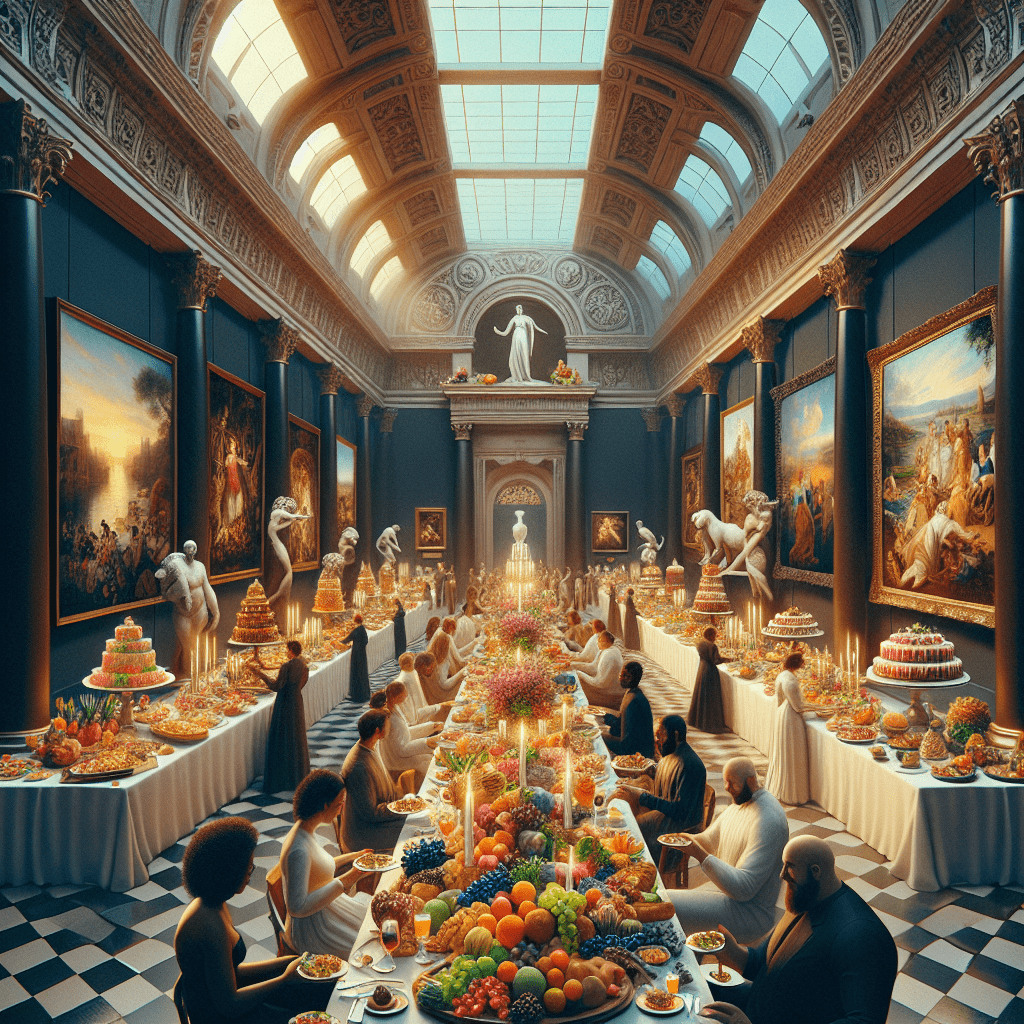[ad_1]
## Feasting with the Eyes: Exploring the World of Food-Inspired Art
In a world where the senses of taste and sight intertwine, the genre of food-inspired art emerges as a testament to humanity’s enduring fascination with the culinary arts. This unique blend of gastronomy and visual art invites viewers to feast with their eyes, teasing the palate with vibrant visuals that evoke the flavors, textures, and aromas of the depicted fare. From ancient frescoes to contemporary installations, the journey through food-inspired art is as much about cultural exploration as it is about aesthetic appreciation.
### The Historical Plateau
The tradition of incorporating food into artistic representations dates back to ancient civilizations. The Romans, for example, adorned their lavish villas with frescoes of fruit baskets and banquet scenes, symbolizing abundance and hedonism. These works not only served decorative purposes but also reflected societal values and the pivotal role of feasting in social cohesion.
Moving forward to the Dutch Golden Age, the genre of still life painting, particularly vanitas and ontbijtjes (breakfast pieces), gained prominence. Artists like Pieter Claesz and Willem Claesz. Heda masterfully captured the texture of bread crusts, the translucency of goblets, and the reflectiveness of silverware, turning ordinary table settings into profound reflections on mortality and the fleeting nature of worldly pleasures.
### Contemporary Cravings
In contemporary times, the exploration of food in art has taken novel directions, reflecting modern society’s concerns and fascinations. From addressing issues of consumerism and globalization to celebrating local gastronomies and sustainable practices, today’s artists use food as a medium to engage with pressing social, environmental, and economic themes.
One notable example is the work of Italian artist Maurizio Cattelan, who famously duct-taped a banana to a wall, creating a global sensation and prompting discussions about value, impermanence, and consumer culture in the art world. Similarly, artists like Jennifer Rubell engage audiences through interactive installations, where art becomes something to be touched, smelled, and tasted, dismantling the traditional boundaries between the viewer and the artwork.
### The Sensory Feast
What sets food-inspired art apart is its ability to engage the viewer’s senses in a multidimensional experience. The visual representation of food evokes assumptions about its taste and smell, bridging the gap between the tangible and intangible. This sensory interplay is particularly evident in hyper-realistic paintings and sculptures that challenge the viewer’s perception of reality and illusion.
Furthermore, food art often incorporates elements of humor and nostalgia, tapping into the universal language of comfort food and shared meals. This emotional layer adds depth to the visual experience, making food-inspired art an accessible and universally appealing genre.
### Future Flavors
As we look to the future, food-inspired art is set to evolve in new and exciting directions, driven by technological innovation and a deeper understanding of the role of food in societal well-being. Augmented reality (AR) and virtual reality (VR) offer new platforms for immersive food art experiences, where viewers can virtually taste and smell the artworks, blurring the lines between the virtual and real world even further.
Moreover, the rise of social media has democratized the art world, allowing food artists to share their creations with a global audience. Instagram, in particular, has become a vibrant canvas for culinary artists, food stylists, and photographers to showcase their edible masterpieces, pushing the boundaries of traditional food presentation and art.
### FAQs
#### Q1: What is food-inspired art?
**A1:** Food-inspired art refers to artworks that feature food as the main subject or theme. This genre encompasses a wide range of mediums, including paintings, sculptures, installations, and digital art, and aims to evoke the sensory experiences associated with food.
#### Q2: Has food always been a popular subject in art?
**A2:** Yes, food has been a popular subject in art since ancient times. Different eras have seen varying interpretations and significances attached to food in art, reflecting the cultural, societal, and economic contexts of the times.
#### Q3: What are some common themes explored in food-inspired art?
**A3:** Common themes include abundance and excess, the ephemerality of life, consumer culture, sustainability, and the social and communal aspects of dining and food preparation.
#### Q4: How do contemporary artists use food in their artworks?
**A4:** Contemporary artists use food both as a subject and a medium to explore various themes, including consumerism, environmental issues, and the relationship between food and identity. They also experiment with novel presentations and interactive installations to engage viewers more deeply.
#### Q5: How has technology influenced food-inspired art?
**A5:** Technology, particularly AR and VR, has opened new avenues for immersive art experiences, allowing viewers to engage with food art in multi-sensory ways. Social media has also played a significant role in promoting and evolving the genre, making it more accessible to a wider audience.
#### Q6: Can food art only be appreciated visually?
**A6:** While visual appreciation is a significant aspect of food art, the genre also aims to engage other senses such as taste, smell, and touch, especially in interactive installations and performances, enriching the overall experience.
### Conclusion
Food-inspired art serves as a mirror, reflecting the complexities and delights of human interaction with food. It transcends mere visual representation, becoming a sensory and emotional journey that nourishes both the body and the soul. As our relationship with food continues to evolve, so too will the ways in which artists draw upon this rich source of inspiration, serving up new visual feasts for the eyes and beyond.
[ad_2]

Leave a Reply